

The Brazilian Town Where the American Confederacy Lives On. One day last spring, near an old rural cemetery in southern Brazil, a black man named Marcelo Gomes held up the corners of a Confederate flag to pose for a cell-phone photo.
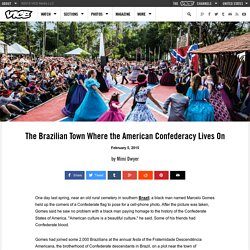
After the picture was taken, Gomes said he saw no problem with a black man paying homage to the history of the Confederate States of America. "American culture is a beautiful culture," he said. Some of his friends had Confederate blood. Is Vermont the solution to the border crisis? In its efforts to figure out what to do with the many Central American unaccompanied minors coming to the United States -- about 60,000 in recent weeks -- the White House has been asking several states if they have the resources to house some of these children.

The office of Vermont's Democratic Gov. Pete Shumlin (D) told a local newspaper, "We've let HHS know that we are willing to investigate locations and logistical requirements and work with them to determine if Vermont would be an appropriate host state. " An apple orchard of the Vermont Hard Cider Company is seen in Middlebury, Vermont in this undated picture provided by the Vermont Hard Cider Company. REUTERS/Vermont Hard Cider Company/Handout via Reuter It's perhaps unsurprising that the state would be willing to help. The fact that their constituency back in Vermont is a big part of that support is less well known; about 1,500 undocumented immigrants live in Vermont, many working on dairy farms.
The Civil War as Photographed by Mathew Brady. Background.
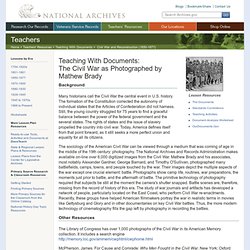
The Gettysburg Address by Abraham Lincoln. Nicolay Copy Named for John G.
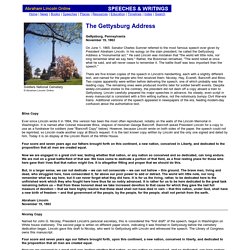
Nicolay, President Lincoln's personal secretary, this is considered the "first draft" of the speech, begun in Washington on White house stationery. The second page is writen on different paper stock, indicating it was finished in Gettysburg before the cemetery dedication began. Lincoln gave this draft to Nicolay, who went to Gettysburg with Lincoln and witnessed the speech. The Library of Congress owns this manuscript. A Visit from the Old Mistress. The Civil War in Art : Teaching & Learning Through Chicago Collections. The Effects of the Proclamation [Freed Negroes Coming into our Lines at Newbern, North Carolina]February 21, 1863Unknown soldier (sketch sent in by amateur)Page 116Harper's Weekly: A Journal of Civilization.
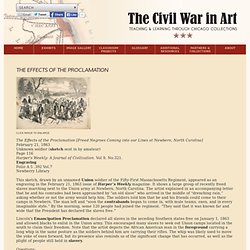
Vol 9, No.321.EngravingFolio A 5 .392 Vol.7Newberry Library This sketch, drawn by an unnamed Union soldier of the Fifty-First Massachusetts Regiment, appeared as an engraving in the February 21, 1863 issue of Harper’s Weekly magazine. It shows a large group of recently freed slaves marching next to the Union army at Newbern, North Carolina. The artist explained in an accompanying letter that he and his comrades had been approached by “an old slave” who arrived in the middle of “drenching rain,” asking whether or not the army would help him.
The soldiers told him that he and his friends could come to their camps in Newbern. Lincoln's Emancipation Proclamation declared all slaves in the seceding Southern states free on January 1, 1863 and allowed blacks to enlist in the Union army. The Civil War in Art : Teaching & Learning Through Chicago Collections. Old Virginia Home 1864 David Gilmour Blythe 1815-1865 Oil on canvas 20 3/4 x 28 3/4 in.The Art Institute of ChicagoAda Turnbull Hertle Fund 1979.55 What do you think is the fate of the man walking away from this burning house?
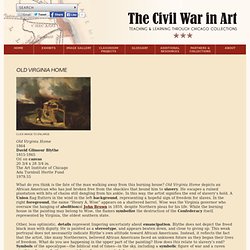
Old Virginia Home depicts an African American who has just broken free from the shackles that bound him to slavery. He escapes a ruined plantation with bits of chains still dangling from his ankle. The Civil War in Art : Teaching & Learning Through Chicago Collections. Negroes Leaving Their HomeApril 9, 1864Unknown ArtistPage 237Harper's Weekly: A Journal of Civilization.
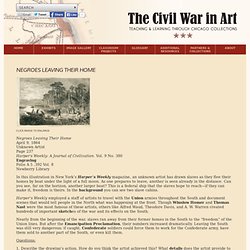
Vol. 9 No. 380EngravingFolio A 5 .392 Vol. 8Newberry Library In this illustration in New York’s Harper’s Weekly magazine, an unknown artist has drawn slaves as they flee their homes by boat under the light of a full moon. As one prepares to leave, another is seen already in the distance. Can you see, far on the horizon, another larger boat? This is a federal ship that the slaves hope to reach—if they can make it, freedom is theirs. File:ACW Western Theater Overview.png. Transcript of Gettysburg Address (1863) Executive Mansion, Washington, , 186 .
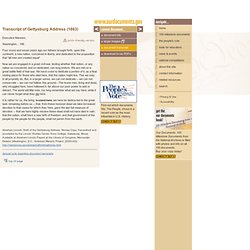
Four score and seven years ago our fathers brought forth, upon this continent, a new nation, conceived in liberty, and dedicated to the proposition that "all men are created equal" Now we are engaged in a great civil war, testing whether that nation, or any nation so conceived, and so dedicated, can long endure. We are met on a great battle field of that war. We have come to dedicate a portion of it, as a final resting place for those who died here, that the nation might live. Jerry Seinfeld And Louis C.K. Talk About The Gettysburg Address. Picturingamerica.neh.gov/downloads/pdfs/Resource_Guide_Chapters/PictAmer_Resource_Book_Chapter_10A.pdf.
Augustus Saint-Gaudens' Memorial to Robert Gould Shaw and the Massachusetts 54th Regiment. The Shaw Memorial - Saint-Gaudens National Historic Site. Shaw Memorial, final version, Saint-Gaudens National Historic Site Special exhibit July 18 - October 31, in the Picture GalleryCONSECRATION & MONUMENT: Robert Gould Shaw and the 54th Massachusetts Regiment The Shaw Memorial remains one of sculptor Augustus Saint-Gaudens' most stirring and celebrated masterpieces and is considered by some to be America's greatest public monument.
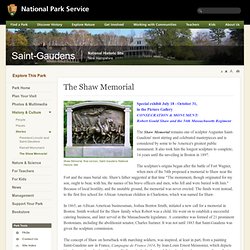
Robert Gould Shaw and the 54th Regiment - Boston African American National Historic Site. Robert Gould Shaw Memorial Boston African American NHS/ NPS.

For the Union Dead - Robert Lowell. Picturingamerica.neh.gov/downloads/pdfs/Resource_Guide_Chapters/PictAmer_Resource_Book_Chapter_10A.pdf. Augustus Saint-Gaudens' Memorial to Robert Gould Shaw and the Massachusetts 54th Regiment. The Shaw Memorial - Saint-Gaudens National Historic Site. Robert Gould Shaw and the 54th Regiment - Boston African American National Historic Site. WFotW ~ The Sartoris Family Genealogy. Explore The Address, A Film by Ken Burns. For the Union Dead - Robert Lowell. The cultural crater of '12 Years a Slave' It is a grim sight, the man hanging from a tree. His neck is noosed. His arms are tied behind him. Making 'Killer Angels' Correction Appended Disunion follows the Civil War as it unfolded.
One-hundred-and-one summers after the Battle of Gettysburg, a family of four stopped their Nash Rambler at the site during a 1,000-mile drive from the New York World’s Fair to Tallahassee, Fla. The father was a New Jersey-born former boxer, paratrooper and policeman who became a creative writing instructor at Florida State after enrolling to study opera. Before arriving at the park he had published dozens of science-fiction short stories, but nothing about history.
The Road to War. A Nation Divided: The American Civil War and Reconstruction. Manifest Destiny and the Slavery Question. The Civil War and Photography. Disunion follows the Civil War as it unfolded. Roughly 150 years ago, in March or April 1863, a shocking photograph was taken in Louisiana. Unlike most photos, it was given a title, “The Scourged Back,” as if it were a painting hanging in an art museum. UNH student looks at Civil War soldiers, slavery. A University of New Hampshire student research project on the Civil War finds that despite the state being one of the most liberal in the nation at the time, racism was common in the letters of its soldiers, including those who said they supported freeing the slaves. Nathan Marzoli, a history major from Dover, investigated the soldiers’ attitudes for his senior undergraduate research project, “New Hampshire Civil War Soldiers and Slavery.” Marzoli found that, by and large, the soldiers’ attitudes toward slavery were tied to their upbringing and education level.
He said the more educated officers and soldiers appeared to be more abolitionist, while the common soldiers could often be very racist, even though none of them owned slaves. “Racism was abundant in almost all of the soldiers’ letters and diaries, however,” Marzoli said. “Even the staunch abolitionists saw black people as almost inhuman and comical. 400px-US_Slave_Free_1789-1861.gif (400×242) I Hear America Singing - Whitman. The Civil War . In the Classroom . Using the Series . Episode One.
Beginning with a searing indictment of slavery, this first episode dramatically evokes the causes of the war, from the Cotton Kingdom of the South to the northern abolitionists who opposed it. Here are the burning questions of Union and States’ rights, John Brown at Harper’s Ferry, the election of Abraham Lincoln in 1860, the firing on Fort Sumter and the jubilant rush to arms on both sides. Along the way the series’ major figures are introduced: Abraham Lincoln, Frederick Douglass, Robert E.
Lee, Ulysses S. Grant and a host of lesser-known but equally vivid characters. The episode comes to a climax with the disastrous Union defeat at Manassas, Virginia, where both sides now learn it is to be a very long war. Detailed Episode Description with time code: 1.4 Chapter 4 - Are We Free? 1.6 Chapter 6 - The Meteor :27:46 - :32:43 John Brown raids the arsenal at Harper's Ferry in 1859, and is captured by Colonel Robert E.